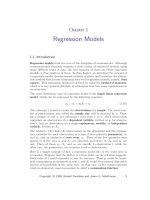foundations of planning
Bạn đang xem bản rút gọn của tài liệu. Xem và tải ngay bản đầy đủ của tài liệu tại đây (351.31 KB, 29 trang )
ninth edition
STEPHEN P. ROBBINS
© 2007 Prentice Hall, Inc.
© 2007 Prentice Hall, Inc.
All rights reserved.
All rights reserved.
PowerPoint Presentation by Charlie Cook
PowerPoint Presentation by Charlie Cook
The University of West Alabama
The University of West Alabama
MARY COULTER
Foundations
Foundations
of Planning
of Planning
Chapter
Chapter
7
7
© 2007 Prentice Hall, Inc. All rights
reserved.
7–2
L E A R N I N G O U T L I N E
L E A R N I N G O U T L I N E
Follow this Learning Outline as you read and study this chapter.
Follow this Learning Outline as you read and study this chapter.
What Is Planning?
What Is Planning?
•
Define planning.
Define planning.
•
Differentiate between formal and informal planning.
Differentiate between formal and informal planning.
•
Describe the purposes of planning.
Describe the purposes of planning.
•
Discuss the conclusions from studies of the relationship
Discuss the conclusions from studies of the relationship
between planning and performance.
between planning and performance.
How Do Managers Plan?
How Do Managers Plan?
•
Define goals and plans.
Define goals and plans.
•
Describe the types of goals organizations might have.
Describe the types of goals organizations might have.
•
Explain why it’s important to know an organization’s stated
Explain why it’s important to know an organization’s stated
and real goals.
and real goals.
•
Describe each of the different types of plans.
Describe each of the different types of plans.
© 2007 Prentice Hall, Inc. All rights
reserved.
7–3
L E A R N I N G O U T L I N E (cont’d)
L E A R N I N G O U T L I N E (cont’d)
Follow this Learning Outline as you read and study this chapter.
Follow this Learning Outline as you read and study this chapter.
Establishing Goals and Developing Plans
Establishing Goals and Developing Plans
•
Discuss how traditional goal setting works.
Discuss how traditional goal setting works.
•
Explain the concept of the means
Explain the concept of the means
–
–
end chain.
end chain.
•
Describe the management by objective (MBO) approach.
Describe the management by objective (MBO) approach.
•
Describe the characteristics of well-designed goals.
Describe the characteristics of well-designed goals.
•
Explain the steps in setting goals.
Explain the steps in setting goals.
•
Discuss the contingency factors that affect planning.
Discuss the contingency factors that affect planning.
•
Describe the approaches to planning.
Describe the approaches to planning.
© 2007 Prentice Hall, Inc. All rights
reserved.
7–4
L E A R N I N G O U T L I N E (cont’d)
L E A R N I N G O U T L I N E (cont’d)
Follow this Learning Outline as you read and study this chapter.
Follow this Learning Outline as you read and study this chapter.
Contemporary Issues in Planning
Contemporary Issues in Planning
•
Explain the criticisms of planning and whether they’re
Explain the criticisms of planning and whether they’re
valid.
valid.
•
Describe how managers can effectively plan in today’s
Describe how managers can effectively plan in today’s
dynamic environment.
dynamic environment.
© 2007 Prentice Hall, Inc. All rights
reserved.
7–5
What Is Planning?
What Is Planning?
•
Planning
Planning
A primary managerial activity that involves:
A primary managerial activity that involves:
Defining the organization’s goals
Defining the organization’s goals
Establishing an overall strategy for achieving those goals
Establishing an overall strategy for achieving those goals
Developing plans for organizational work activities.
Developing plans for organizational work activities.
Types of planning
Types of planning
Informal:
Informal:
not written down, short-term focus; specific to an
not written down, short-term focus; specific to an
organizational unit.
organizational unit.
Formal:
Formal:
written, specific, and long-term focus, involves
written, specific, and long-term focus, involves
shared goals for the organization.
shared goals for the organization.
© 2007 Prentice Hall, Inc. All rights
reserved.
7–6
Why Do Managers Plan?
Why Do Managers Plan?
•
Purposes of Planning
Purposes of Planning
Provides direction
Provides direction
Reduces uncertainty
Reduces uncertainty
Minimizes waste and redundancy
Minimizes waste and redundancy
Sets the standards for controlling
Sets the standards for controlling
© 2007 Prentice Hall, Inc. All rights
reserved.
7–7
Planning and Performance
Planning and Performance
•
The Relationship Between Planning And
The Relationship Between Planning And
Performance
Performance
Formal planning is associated with:
Formal planning is associated with:
Higher profits and returns on assets.
Higher profits and returns on assets.
Positive financial results.
Positive financial results.
The quality of planning and implementation affects
The quality of planning and implementation affects
performance more than the extent of planning.
performance more than the extent of planning.
The external environment can reduce the impact of
The external environment can reduce the impact of
planning on performance,
planning on performance,
Formal planning must be used for several years
Formal planning must be used for several years
before planning begins to affect performance.
before planning begins to affect performance.
© 2007 Prentice Hall, Inc. All rights
reserved.
7–8
How Do Managers Plan?
How Do Managers Plan?
•
Elements of Planning
Elements of Planning
Goals (also Objectives)
Goals (also Objectives)
Desired outcomes for individuals, groups, or entire
Desired outcomes for individuals, groups, or entire
organizations
organizations
Provide direction and evaluation performance criteria
Provide direction and evaluation performance criteria
Plans
Plans
Documents that outline how goals are to be accomplished
Documents that outline how goals are to be accomplished
Describe how resources are to be allocated and establish
Describe how resources are to be allocated and establish
activity schedules
activity schedules
© 2007 Prentice Hall, Inc. All rights
reserved.
7–9
Types of Goals
Types of Goals
•
Financial Goals
Financial Goals
Are related to the expected internal financial
Are related to the expected internal financial
performance of the organization.
performance of the organization.
•
Strategic Goals
Strategic Goals
Are related to the performance of the firm relative to
Are related to the performance of the firm relative to
factors in its external environment (e.g., competitors).
factors in its external environment (e.g., competitors).
•
Stated Goals versus Real Goals
Stated Goals versus Real Goals
Broadly-worded official statements of the organization
Broadly-worded official statements of the organization
(intended for public consumption) that may be
(intended for public consumption) that may be
irrelevant to its real goals (what actually goes on in
irrelevant to its real goals (what actually goes on in
the organization).
the organization).
© 2007 Prentice Hall, Inc. All rights
reserved.
7–10
Exhibit 7–1
Exhibit 7–1
Stated Goals of Large Global Companies
Stated Goals of Large Global Companies
Execute strategic roadmap—“Plan to Win.”
Grow the business profitably.
Identify and develop diverse talent.
Promote balanced, active lifestyles.
(McDonald’s Corporation)
Continue to win market share globally.
Focus on higher-value products.
Reduce production costs.
Lower purchasing costs.
Integrate diversity.
Gain ISO 14001 certification for all factories.
(L’Oreal)
Respect the environment.
Respect and support family unity and national
traditions.
Promote community welfare.
Continue implementing quality systems.
Continue to be a strong cash generator.
(Grupo Bimbo)
Control inventory.
Maintain industry’s lowest inventory shrinkage rate.
Open 25–30 new locations in fiscal 2006.
Live by the code of ethics every day.
(Costco)
Expand selection of competitively priced products.
Manage inventory carefully.
Continue to improve store format every few years.
Operate 2,000 stores by the end of the decade.
Continue gaining market share.
(Target)
Roll out newly-designed environmentally friendly
cup in 2006.
Open approximately 1,800 new stores globally in
2006.
Attain net revenue growth of approximately 20
percent in 2006.
Attain annual EPS growth of between 20 percent to
25 percent for the next 3 to 5 years.
(Starbucks)
Source: Information from company’s Annual Reports, 2004–2005.
© 2007 Prentice Hall, Inc. All rights
reserved.
7–11
Exhibit 7–2
Exhibit 7–2
Types of Plans
Types of Plans
© 2007 Prentice Hall, Inc. All rights
reserved.
7–12
Types of Plans
Types of Plans
•
Strategic Plans
Strategic Plans
Apply to the entire organization.
Apply to the entire organization.
Establish the organization’s overall goals.
Establish the organization’s overall goals.
Seek to position the organization in terms of its
Seek to position the organization in terms of its
environment.
environment.
Cover extended periods of time.
Cover extended periods of time.
•
Operational Plans
Operational Plans
Specify the details of how the overall goals are to be
Specify the details of how the overall goals are to be
achieved.
achieved.
Cover short time period.
Cover short time period.
© 2007 Prentice Hall, Inc. All rights
reserved.
7–13
Types of Plans (cont’d)
Types of Plans (cont’d)
•
Long-Term Plans
Long-Term Plans
Plans with time frames extending beyond three years
Plans with time frames extending beyond three years
•
Short-Term Plans
Short-Term Plans
Plans with time frames on one year or less
Plans with time frames on one year or less
•
Specific Plans
Specific Plans
Plans that are clearly defined and leave no room for
Plans that are clearly defined and leave no room for
interpretation
interpretation
•
Directional Plans
Directional Plans
Flexible plans that set out general guidelines, provide
Flexible plans that set out general guidelines, provide
focus, yet allow discretion in implementation.
focus, yet allow discretion in implementation.
© 2007 Prentice Hall, Inc. All rights
reserved.
7–14
Exhibit 7–3
Exhibit 7–3
Specific Versus Directional Plans
Specific Versus Directional Plans
© 2007 Prentice Hall, Inc. All rights
reserved.
7–15
Types of Plans (cont’d)
Types of Plans (cont’d)
•
Single-Use Plan
Single-Use Plan
A one-time plan specifically designed to meet the
A one-time plan specifically designed to meet the
need of a unique situation.
need of a unique situation.
•
Standing Plans
Standing Plans
Ongoing plans that provide guidance for activities
Ongoing plans that provide guidance for activities
performed repeatedly.
performed repeatedly.
© 2007 Prentice Hall, Inc. All rights
reserved.
7–16
Establishing Goals and
Establishing Goals and
Developing Plans
Developing Plans
•
Traditional Goal Setting
Traditional Goal Setting
Broad goals are set at the top of the organization.
Broad goals are set at the top of the organization.
Goals are then broken into subgoals for each
Goals are then broken into subgoals for each
organizational level.
organizational level.
Assumes that top management knows best because
Assumes that top management knows best because
they can see the “big picture.”
they can see the “big picture.”
Goals are intended to direct, guide, and constrain from
Goals are intended to direct, guide, and constrain from
above.
above.
Goals lose clarity and focus as lower-level managers
Goals lose clarity and focus as lower-level managers
attempt to interpret and define the goals for their areas
attempt to interpret and define the goals for their areas
of responsibility.
of responsibility.
© 2007 Prentice Hall, Inc. All rights
reserved.
7–17
Exhibit 7–4
Exhibit 7–4
The Downside of Traditional Goal Setting
The Downside of Traditional Goal Setting
© 2007 Prentice Hall, Inc. All rights
reserved.
7–18
Establishing Goals and Developing
Establishing Goals and Developing
Plans (cont’d)
Plans (cont’d)
•
Maintaining the Hierarchy of Goals
Maintaining the Hierarchy of Goals
Means–Ends Chain
Means–Ends Chain
The integrated network of goals that results from establishing
The integrated network of goals that results from establishing
a clearly-defined hierarchy of organizational goals.
a clearly-defined hierarchy of organizational goals.
Achievement of lower-level goals is the means by which to
Achievement of lower-level goals is the means by which to
reach higher-level goals (ends).
reach higher-level goals (ends).
© 2007 Prentice Hall, Inc. All rights
reserved.
7–19
Establishing Goals and Developing
Establishing Goals and Developing
Plans (cont’d)
Plans (cont’d)
•
Management By Objectives (MBO)
Management By Objectives (MBO)
Specific performance goals are jointly determined by
Specific performance goals are jointly determined by
employees and managers.
employees and managers.
Progress toward accomplishing goals is periodically
Progress toward accomplishing goals is periodically
reviewed.
reviewed.
Rewards are allocated on the basis of progress
Rewards are allocated on the basis of progress
towards the goals.
towards the goals.
Key elements of MBO:
Key elements of MBO:
Goal specificity, participative decision making, an explicit
Goal specificity, participative decision making, an explicit
performance/evaluation period, feedback
performance/evaluation period, feedback
© 2007 Prentice Hall, Inc. All rights
reserved.
7–20
Exhibit 7–5
Exhibit 7–5
Steps in a Typical MBO Program
Steps in a Typical MBO Program
1. The organization’s overall objectives and strategies are
formulated.
2. Major objectives are allocated among divisional and departmental
units.
3. Unit managers collaboratively set specific objectives for their
units with their managers.
4. Specific objectives are collaboratively set with all department
members.
5. Action plans, defining how objectives are to be achieved, are
specified and agreed upon by managers and employees.
6. The action plans are implemented.
7. Progress toward objectives is periodically reviewed, and
feedback is provided.
8. Successful achievement of objectives is reinforced by
performance-based rewards.
© 2007 Prentice Hall, Inc. All rights
reserved.
7–21
Does MBO Work?
Does MBO Work?
•
Reason for MBO Success
Reason for MBO Success
Top management commitment and involvement
Top management commitment and involvement
•
Potential Problems with MBO Programs
Potential Problems with MBO Programs
Not as effective in dynamic environments that require
Not as effective in dynamic environments that require
constant resetting of goals.
constant resetting of goals.
Overemphasis on individual accomplishment may
Overemphasis on individual accomplishment may
create problems with teamwork.
create problems with teamwork.
Allowing the MBO program to become an annual
Allowing the MBO program to become an annual
paperwork shuffle.
paperwork shuffle.
© 2007 Prentice Hall, Inc. All rights
reserved.
7–22
Exhibit 7–6
Exhibit 7–6
Characteristics of Well-Designed Goals
Characteristics of Well-Designed Goals
•
Written in terms of
Written in terms of
outcomes, not actions
outcomes, not actions
Focuses on the ends, not
Focuses on the ends, not
the means.
the means.
•
Measurable and
Measurable and
quantifiable
quantifiable
Specifically defines how the
Specifically defines how the
outcome is to be measured
outcome is to be measured
and how much is expected.
and how much is expected.
•
Clear as to time frame
Clear as to time frame
How long before measuring
How long before measuring
accomplishment.
accomplishment.
•
Challenging yet attainable
Challenging yet attainable
Low goals do not motivate.
Low goals do not motivate.
High goals motivate if they
High goals motivate if they
can be achieved.
can be achieved.
•
Written down
Written down
Focuses, defines, and
Focuses, defines, and
makes goals visible.
makes goals visible.
•
Communicated to all
Communicated to all
necessary organizational
necessary organizational
members
members
Puts everybody “on the
Puts everybody “on the
same page.”
same page.”
© 2007 Prentice Hall, Inc. All rights
reserved.
7–23
Steps in Goal Setting
Steps in Goal Setting
1.
1.
Review the organization’s mission statement.
Review the organization’s mission statement.
Do goals reflect the mission?
Do goals reflect the mission?
2.
2.
Evaluate available resources.
Evaluate available resources.
Are resources sufficient to accomplish the mission?
Are resources sufficient to accomplish the mission?
3.
3.
Determine goals individually or with others.
Determine goals individually or with others.
Are goals specific, measurable, and timely?
Are goals specific, measurable, and timely?
4.
4.
Write down the goals and communicate them.
Write down the goals and communicate them.
Is everybody on the same page?
Is everybody on the same page?
5.
5.
Review results and whether goals are being met.
Review results and whether goals are being met.
What changes are needed in mission, resources, or goals?
What changes are needed in mission, resources, or goals?
© 2007 Prentice Hall, Inc. All rights
reserved.
7–24
Developing Plans
Developing Plans
•
Contingency Factors in A Manager’s Planning
Contingency Factors in A Manager’s Planning
Manager’s level in the organization
Manager’s level in the organization
Strategic plans at higher levels
Strategic plans at higher levels
Operational plans at lower levels
Operational plans at lower levels
Degree of environmental uncertainty
Degree of environmental uncertainty
Stable environment: specific plans
Stable environment: specific plans
Dynamic environment: specific but flexible plans
Dynamic environment: specific but flexible plans
Length of future commitments
Length of future commitments
Commitment Concept:
Commitment Concept:
current plans affecting future
current plans affecting future
commitments must be sufficiently long-term to meet those
commitments must be sufficiently long-term to meet those
commitments.
commitments.
© 2007 Prentice Hall, Inc. All rights
reserved.
7–25
Exhibit 7–7
Exhibit 7–7
Planning in the Hierarchy of Organizations
Planning in the Hierarchy of Organizations





![mathematical foundations of scientific visualization, computer graphics, and massive data exploration [electronic resource]](https://media.store123doc.com/images/document/14/y/up/medium_upb1401358803.jpg)



